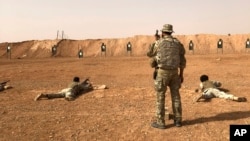U.S. forces in Iraq and Syria have been attacked with drones or rockets by Iranian-backed groups at least 38 times in less than a month, including six attacks in the last two days, according to the Pentagon.
Most of these attacks were disrupted by the U.S. military or failed to reach their targets, causing no casualties or damage to infrastructure, defense officials said.
The attacks have injured 46 U.S. military personnel, more than double the injuries previously reported, according to numbers provided Monday by Pentagon press secretary Brigadier General Pat Ryder.
“These could be things like shrapnel, headaches, perforated eardrums, tinnitus, rolled ankle,” Ryder said, along with traumatic brain injuries.
The American injuries occurred during four attacks: a drone attack at Al-Harir Air Base in Irbil, where the drone crashed prior to exploding; two multidrone attacks at Al-Asad Air Base in western Iraq, and a multidrone attack at Al-Tanf garrison in Syria.
All wounded personnel returned to duty following their injuries, Ryder told reporters Monday. However, two U.S. personnel who had been treated for traumatic brain injuries and originally returned to duty were subsequently sent to Landstuhl Regional Medical Center in Germany for further examination.
“They are in stable condition, so this is out of an abundance of caution,” Ryder said.
At least 16 of the largely unsuccessful attacks against American personnel were carried out after U.S. forces struck a weapons storage facility and an ammunition facility in eastern Syria last Friday, which the Pentagon said were used by Iran's Islamic Revolutionary Guard Corps and affiliated groups.
Sunday marked the highest number of attacks in a single day since the attacks began last month. Two drone attacks targeted Al-Asad Air Base in western Iraq, one multidrone and multirocket attack against Al-Asad, and two drone attacks at two bases housing U.S. troops in Syria.
Several lawmakers last week raised concern that the military’s first response to the attacks in Iraq and Syria wasn’t strong enough.
“If we do not have a credible … deterrence with Iranians, these attacks are going to escalate. They're going to come faster, they're going to spread beyond Syria and Iraq, and they will involve weaponry of increasing sophistication and legality. That is my biggest fear,” Republican Senator Marco Rubio said Oct. 31 during a Senate Appropriations Committee hearing.
“If this doesn’t stop, then we will respond,” Secretary of Defense Lloyd Austin said while testifying during that same hearing last Tuesday.
The U.S. has deployed more than 1,200 troops to the region to protect U.S. forces in Iraq and Syria and to be prepared should Iranian-backed enemies try to broaden and expand the conflict in Israel. These units include a Terminal High Altitude Area Defense, or THAAD, battery, Patriot batteries and Avenger batteries.
The USS Eisenhower carrier strike group, the USS Ford carrier strike group and other ships are patrolling in waters nearby.
The attacks since Oct. 17 on U.S. and coalition forces have resulted in 32 minor injuries to Americans in Syria and 14 minor injuries to American personnel in Iraq, with U.S. officials continuing to monitor for any more potential traumatic brain injuries.
One U.S. contractor at al-Asad Air Base in Iraq suffered a cardiac episode and died while sheltering in place during a false alarm for an air attack.





